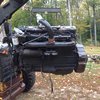JAKES.
Well-Known Member
Hi I was hoping those of you more seasoned people out there might know what I am looking at: I am looking at a running thermodyne it is a n/a, 2 valve,fuel pump with mechanical governor attached, the head has 20 bolts. which is all normal I am just wondering about the number stamped on the timing cover which reads:673E-5115727 . I thought all the n/a thermodynes would be stamped 673END ….. and the newer turboed ones would be 673ENDT.... so I just wondering why this one is just 673E.....? I just want learn some more about this one if anyone happens to know.



